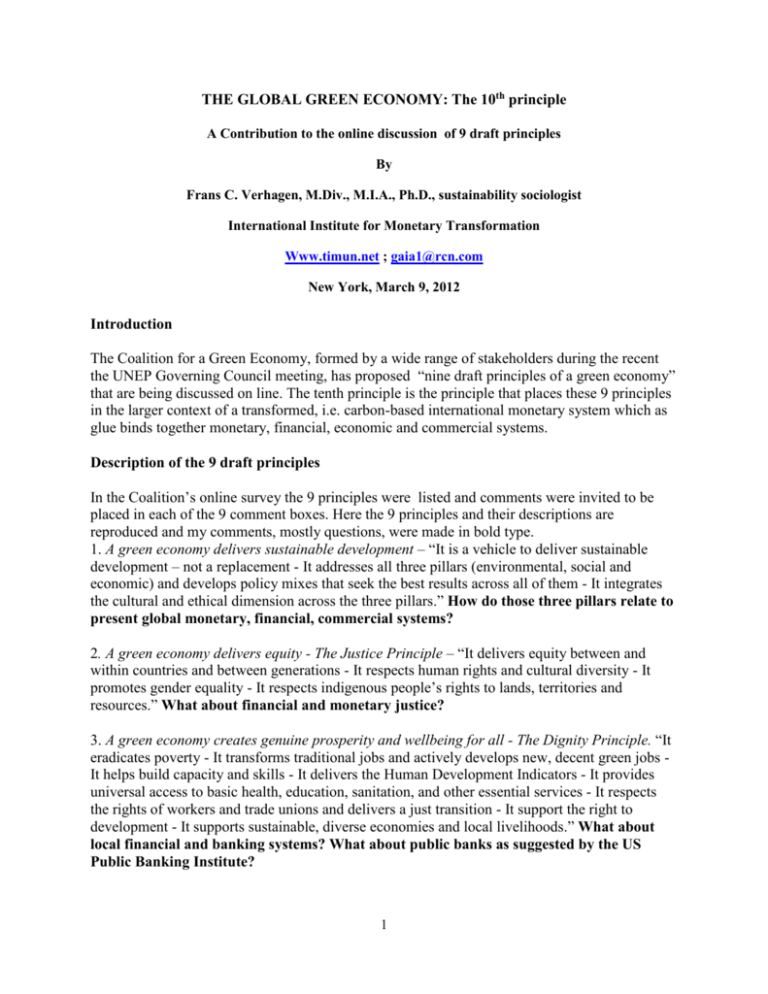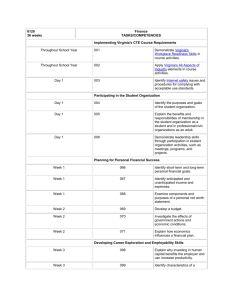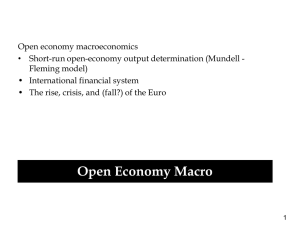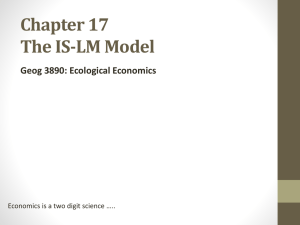nine draft principles of a green economy
advertisement

THE GLOBAL GREEN ECONOMY: The 10th principle A Contribution to the online discussion of 9 draft principles By Frans C. Verhagen, M.Div., M.I.A., Ph.D., sustainability sociologist International Institute for Monetary Transformation Www.timun.net ; gaia1@rcn.com New York, March 9, 2012 Introduction The Coalition for a Green Economy, formed by a wide range of stakeholders during the recent the UNEP Governing Council meeting, has proposed “nine draft principles of a green economy” that are being discussed on line. The tenth principle is the principle that places these 9 principles in the larger context of a transformed, i.e. carbon-based international monetary system which as glue binds together monetary, financial, economic and commercial systems. Description of the 9 draft principles In the Coalition’s online survey the 9 principles were listed and comments were invited to be placed in each of the 9 comment boxes. Here the 9 principles and their descriptions are reproduced and my comments, mostly questions, were made in bold type. 1. A green economy delivers sustainable development – “It is a vehicle to deliver sustainable development – not a replacement - It addresses all three pillars (environmental, social and economic) and develops policy mixes that seek the best results across all of them - It integrates the cultural and ethical dimension across the three pillars.” How do those three pillars relate to present global monetary, financial, commercial systems? 2. A green economy delivers equity - The Justice Principle – “It delivers equity between and within countries and between generations - It respects human rights and cultural diversity - It promotes gender equality - It respects indigenous people’s rights to lands, territories and resources.” What about financial and monetary justice? 3. A green economy creates genuine prosperity and wellbeing for all - The Dignity Principle. “It eradicates poverty - It transforms traditional jobs and actively develops new, decent green jobs It helps build capacity and skills - It delivers the Human Development Indicators - It provides universal access to basic health, education, sanitation, and other essential services - It respects the rights of workers and trade unions and delivers a just transition - It support the right to development - It supports sustainable, diverse economies and local livelihoods.” What about local financial and banking systems? What about public banks as suggested by the US Public Banking Institute? 1 4. A green economy improves the natural world - The Planetary Boundaries, Earth Integrity and Precautionary Principle. “It recognizes ecological boundaries and seeks to operate within them It delivers environmental justice - It respects the precautionary principle - It assesses of the potential impact of new and untested technologies before they are released - It demonstrates the benefit for the environment through indicators - It ensures an optimum and wise use of natural resources - It safeguards biodiversity loss and prevents pollution - It promotes the restoration of balance in ecological and social relations.”What about incorporating ecological balances of climate debts and credits into a new balance of payments system?” 5. A green economy is inclusive and participatory in decision making - The Inclusion Principle. “It is based on transparency and the visibility of all stakeholders - It supports governance at all levels from global to local - It empowers citizens and promotes full and effective participation at all levels - It fosters cultural values and is sensitive to ethical considerations - It builds societal awareness, developing education and skills - It is inclusive and participatory, giving opportunities to youth, women, poor and low skilled workers, indigenous peoples and local communities.” What will be the global governance system be like to make this Inclusion Principle be possible? 6. A green economy is accountable. - The Governance Principle. “It governs markets in consultation with all stakeholders - It promotes the development of standards to measure progress - It promotes international cooperation and defines International liability - It promotes democracy - It commits to international human rights standards and environmental agreements.” What are the financial, banking and monetary institutions like that are built on this Governance Principle? 7. A green economy builds economic, social and environmental resilience - The Resilience Principle.” It supports the development of social and environmental protection systems - It promotes systems approaches, recognizing the interdependence and integrated nature of these three systems, underpinned by culture and ethical values - It creates resilience by supporting many green economy models relevant to different cultural, social and environmental contexts - It considers indigenous local knowledge and promotes diverse knowledge systems - It builds local skills and capacities. Should such resilient and diverse economic models that are relevant to local communities not be part of a global resilient structure in finance, banking and monetary systems? 8. A green economy delivers sustainable consumption and production - The Efficiency Principle. “It ensures prices reflect true costs incorporating social and environmental externalities - It implements the polluter pays principle - It supports life-cycle management - It strives for zero emission and zero waste - It prioritizes renewable energy and renewable resources - It seeks absolute decoupling production and consumption from negative social and environmental impact - It delivers sustainable lifestyles - It promotes social, economic and environmental innovation It promotes resource efficiency - It gives access to intellectual property rights.” Is such socially and ecologically responsible global economic system compatible with the present neoliberal economic, financial and monetary philosophy? Should we not instead pursue a creditrather than a debt-based financial system, a banking system that is not engaged in money creation but operates on 100% reserves and global international monetary system that is 2 based upon a standard that pushes nations to deal with the climate crisis by decarbonizing their societies? 9. A green economy invests for the future - The Intergenerational Principle. “It ensures the finance sector supports the delivery of diverse sustainable green economies - It promotes longterm decision making above the short term - It regulates the finance sector, constrains speculation and supports the real economy.” Is it not necessary in order to evolve such financial sector the global financial system is to be restructured as credit-based system where governments spend money into circulation as proposed in the 1865 Lincoln Monetary Declaration, by the New Economic Foundation and most recently by adherents of the Modern Monetary Theory in Michael Hudson’s report of the Rimini meeting at www.globalresearch.ca/index.php?context=va&aid=29605 ? Description of the tenth principle The following statement of the 10th principle in the format of the other 9 principles was submitted via https://www.surveymonkey.com/s/LB9Q3GW on March 6 to Emily Benson of http://www.greeneconomycoalition.org. It followed the survey’s suggestion that “10. Now that you have read through the nine draft principles of a green economy, is there anything else you would like to add or share to inform this discussion?” “10. A green economy without an equitable, sustainable, and, therefore, stable global monetary system will not be effective—The monetary principle. —a monetary standard other than the pure or flexible gold standard is to be developed so that volatile exchange rates, currency manipulation and speculation and financial imbalances can be reduced; adopting the SDR as the major reserve currency is an intermediate step on the road to the removal of the expensive global reserve system when currencies have become convertible or a world currency has been adopted. —the Declaration of the Bonn DPI/NGO Conference of September 2011 has asked governments to “rethink the international monetary system to be based upon a carbon standard” (line 265). —a green economy framework that does not give essential attention to the challenge of disruptive climate change will be ineffective; a carbon-based international monetary system would push nations to decarbonize their societies in order to combat climate change because the strength of their economies and their currencies would depend on it.” Rationale for the 10th principle The above questions in bold have connected the 10th principle with the thinking that went into this important effort of finding an integrated value-based planning framework. The main reason for including the monetary principle together with its credit-based financial system and 100% reserve banking as a 10th principle is that such inclusion provides an integration of the three pillars of sustainable development and of the other 9 principles above. 3 The complete rationale for inclusion of the 10th Principle is presented in my forthcoming book The Tierra Solution: Resolving the Climate Crisis through Monetary Transformation, to be published by Cosimo Books in the middle of April. 4









